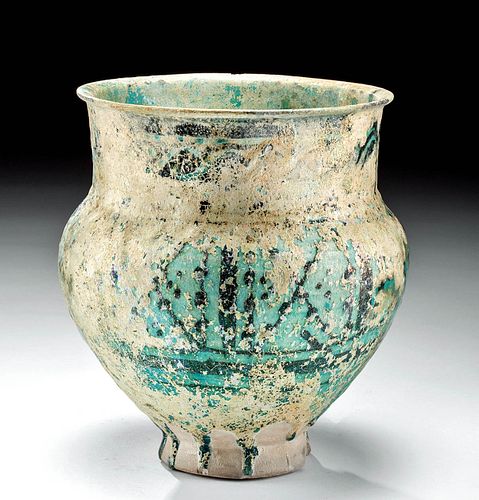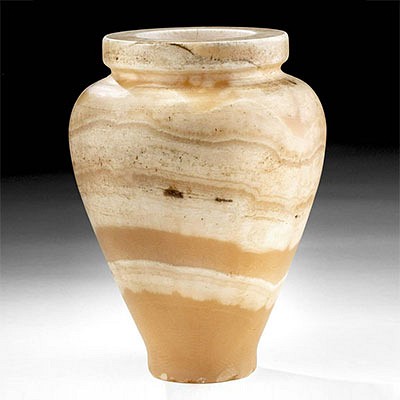10th C. Islamic Nishapur Glazed Pottery Jar
Lot 52a
About Seller
Artemis Gallery
686 S Taylor Ave, Ste 106
Louisville, CO 80027
United States
Selling antiquities, ancient and ethnographic art online since 1993, Artemis Gallery specializes in Classical Antiquities (Egyptian, Greek, Roman, Near Eastern), Asian, Pre-Columbian, African / Tribal / Oceanographic art. Our extensive inventory includes pottery, stone, metal, wood, glass and textil...Read more
Categories
Estimate:
$2,250 - $3,500
Absentee vs Live bid
Two ways to bid:
- Leave a max absentee bid and the platform will bid on your behalf up to your maximum bid during the live auction.
- Bid live during the auction and your bids will be submitted real-time to the auctioneer.
Bid Increments
| Price | Bid Increment |
|---|---|
| $0 | $25 |
| $300 | $50 |
| $1,000 | $100 |
| $2,000 | $250 |
| $5,000 | $500 |
| $10,000 | $1,000 |
| $20,000 | $2,500 |
| $50,000 | $5,000 |
| $100,000 | $10,000 |
| $200,000 | $20,000 |
About Auction
By Artemis Gallery
Dec 17, 2020
Set Reminder
2020-12-17 10:00:00
2020-12-17 10:00:00
America/New_York
Bidsquare
Bidsquare : VARIETY SALE | Antiquities & Ethnographic Art
https://www.bidsquare.com/auctions/artemis-gallery/variety-sale-antiquities-ethnographic-art-6207
Featuring classical antiquities, ancient and ethnographic art from cultures encompassing the globe. Egyptian, Greek, Roman, Etruscan, Near Eastern, Asian, Pre-Columbian, Native American, African / Tribal, Oceanic, Spanish Colonial, Russian, Fossils, Fine Art, more! Artemis Gallery info@artemisgallery.com
Featuring classical antiquities, ancient and ethnographic art from cultures encompassing the globe. Egyptian, Greek, Roman, Etruscan, Near Eastern, Asian, Pre-Columbian, Native American, African / Tribal, Oceanic, Spanish Colonial, Russian, Fossils, Fine Art, more! Artemis Gallery info@artemisgallery.com
- Lot Description
Medieval Near East, Persia (Iran), Nishapur area, ca. late 10th to early 13th century CE. A wheel-thrown pottery jar of a tall form. The inverted piriform body rests upon a squat, flared foot, has a rounded shoulder, and a petite rim surmounting the thin neck. Both the interior and exterior surfaces are enveloped with highly iridescent glaze of lustrous turquoise hues, and across the exterior are black fineline motifs interspersed with stippled and spotted patterns that create an eye-catching presentation. Size: 8" W x 8.6" H (20.3 cm x 21.8 cm)
Nishapur was a center of politics and culture in medieval Persia, and their pottery is some of the most unique and beautiful in history. These turquoise items are the result of technological innovation at the end of the 10th century. The body of this bowl and others of its style is made of finely ground quartz mixed with clay; this created a white surface on which the artists could paint designs directly. The glaze is alkaline, with a copper base to give it its color, and would be poured over the clay. Manganese was used to create the underglaze design. These pieces may have been inspired by the blue and white glazed pottery that travelled the Silk Road from Tang Dynasty China, but the end result here is clearly not just an imitation, but an entirely different, radical style developed in Nishapur.
Provenance: private San Marino, California, USA collection; ex-private estate collection, Los Angeles, California, USA, acquired in the 1970s
All items legal to buy/sell under U.S. Statute covering cultural patrimony Code 2600, CHAPTER 14, and are guaranteed to be as described or your money back.
A Certificate of Authenticity will accompany all winning bids.
We ship worldwide and handle all shipping in-house for your convenience.
#159601Chips to foot and rim, with encrustations along interior and exterior surfaces, and fading to areas of glaze, otherwise intact and excellent. Great preservation to glaze pigment, stunning iridescence, and lovely craquelure throughout.Condition
- Shipping Info
-
All shipping is handled in-house for your convenience. Your invoice from Artemis Gallery will include shipping calculation instructions. If in doubt, please inquire BEFORE bidding for estimated shipping costs for individual items.
-
- Buyer's Premium



 EUR
EUR CAD
CAD AUD
AUD GBP
GBP MXN
MXN HKD
HKD CNY
CNY MYR
MYR SEK
SEK SGD
SGD CHF
CHF THB
THB
















